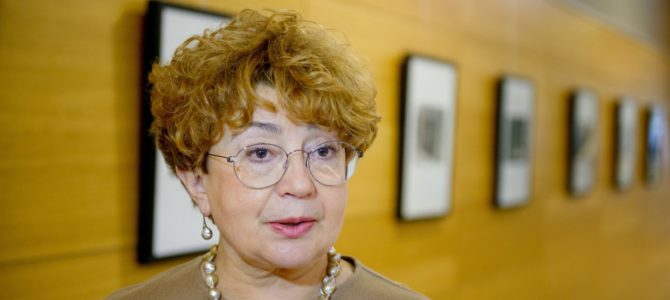by Vytautas Bruveris, lrytas.lt
The country is marking the end of the ceremoniously declared Year of the Vilna Gaon and Litvak History, while the Lithuanian Jewish Community is looking at its front door and thinking it might have to leave its home. Because disagreements with state institutions are driving the Community from its longtime building in the center of the Lithuanian capital, located near the remains of Jewish Vilna and the city’s working synagogue.
Bailiffs and bricklayers in broad daylight have walled off one of the corridors in the building housing the LJC. This is the grotesque turn of events these days resulting from continuing disagreements between the LJC and the Vilna Gaon Jewish History Museum along with the Lithuanian Ministry of Culture. And even before this there were also episodes which seem rather odd, for example, letters from the museum to the members of the executive board of the LJC with accusations against the latter’s leadership, attempting to put political pressure directly upon the ethnic community/
With the new wall built, the LJC is now deciding on its future course: whether to dive headlong into legal battles, or simply pack its bags and hit the street. So why is all this happening? Because of disputes on how to share the courtyard which both the museum and the LJC, housed in the same building, claim. Instead of trying to act as moderator and as a moderating force, the Lithuanian Ministry of Culture has done the opposite. The neighbors are there next to each other, but separate.
The Vilna Gaon museum, which officially changed its name to the Vilna Gaon Jewish History Museum this spring, has ambitious plans to become the main location for commemorating and remembering Jewish history and culture in the country.
With that aim in mind, the museum is taking part in an EU-financed project whose aim is to create a Litvak Culture and Identity Museum as a branch of the Vilna Gaon Jewish History Museum and to renovate in general and “make topical” the building now occupied by the museum. The museum is established in the historical building in the center of Vilnius which it shares with the LJC.
This building once belonged to the Tarbut Hebrew gymnasium. More precisely, back in 2002 the museum which had the right to administer the entire building which actually belongs to the state made an agreement with the LJC of indeterminate duration for the latter’s use of about half the building. In preparation for the large project, the museum divided the building into two property units, one for itself and one for the LJC.
LJC reps say this was done without their knowledge. And this was no less surprising than the fact the museum didn’t inform the LJC of its plans for the project, never mind discussing the LJC’s possible participation in that project.
Last May, however, the museum warned the Community it was canceling the contract, claiming legislation adopted last year required it to do so, outlawing use contracts of indeterminate duration.
The museum says it offered at the same time a new contract of limited duration to the LJC, but that the LJC failed to respond to the warning and to the offer. Meanwhile, the LJC says it wasn’t just sitting around with its hands folded or sleeping. On the contrary, the organization engaged in intensive planning on how to go on, together with the Goodwill Foundation which allocates funding from compensation from the Lithuanian state for Holocaust losses intended for Jewish communal cultural and religious needs.
After long and deep considerations, the Goodwill Foundation decided it could, without violating its own regulations and principles, nonetheless act in such a way that the LJC might acquire the facilities it now occupies as property. It was resolved that the money needed for acquiring the building would simply not be transferred from the state budget to the Goodwill Foundation [since the state owns the building]. The figure being talked about is approximately one million euros.
Then, according to the LJC’s plan, the organization could continue to make use of its headquarters, firmly established over many years and the home to numerous social, cultural and Community events.
Not Sharing the Courtyard
So what has become the main disagreement between the LJC and the museum site? It’s the courtyard of the building where both organizations operate. It seems the LJC, having decided the best course of action is to buy the premises where it’s based, is convinced it’s not worth spending around one million euros if that doesn’t include the courtyard or at least part of it. At the same time, the museum needs the courtyard, or part of it, if only so it can hold activities or stage exhibitions there as specified in the EU project. Thus the Goodwill Foundation has proposed dividing the courtyard in such a way to meet the needs of both.
Full article in Lithuanian here.


